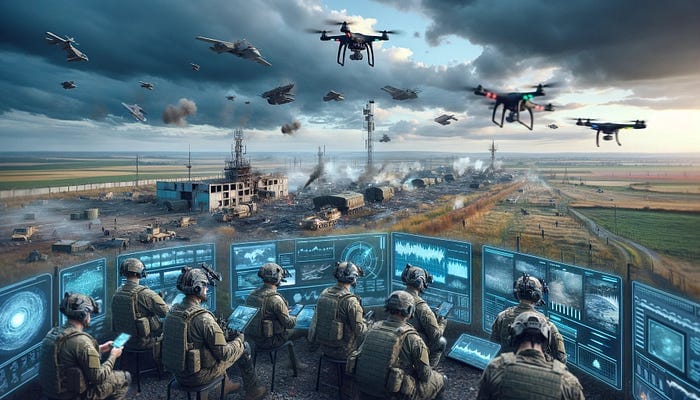AI Technology and Military Strategy

In this short essay, I will dig into the war events in Ukraine. This conflict represents two critical opportunities for BearNetAI’s mission: (1) It’s current, and (2) It reveals how state-of-the-art AI technology is applied to modern-day warfare.
In the 21st century, warfare has transcended the conventional bounds of guns, aircraft, tanks, and troops, morphing into a sophisticated arena where information, technology, and artificial intelligence play pivotal roles. Ukraine’s conflict is a stark demonstration of this evolution, portraying a war zone transformed into an expansive laboratory for military and technological innovation. This short essay delves into the multifaceted involvement of tech companies in Ukraine’s defense efforts, evaluates the implications of such collaborations, and contemplates the ethical and global consequences of this new warfare paradigm.
At the heart of Ukraine’s technological mobilization is Palantir Technologies (https://www.palantir.com), led by CEO Alex Karp, whose bold foray into the conflict zone symbolized the tech industry’s unprecedented commitment to national defense. Palantir’s data analytics and AI software deployment represents the strategic pivot towards leveraging advanced technologies in conflict resolution and defense strategies. This initiative not only underscores the potential of technology to alter the dynamics of warfare but also illustrates a novel form of partnership between nation-states and private enterprises in addressing security challenges.
Other tech giants, such as Microsoft, Amazon, Google, and smaller startups, are also engaging in a collective industry response to this conflict. Their wide-ranging contributions, from cybersecurity defenses to cloud services and facial recognition technologies, highlight a comprehensive approach to supporting Ukraine’s military and civil infrastructures. These collaborative efforts have accelerated the development of military technologies, pushing the envelope of what is possible in modern warfare.
Ukraine’s transformation into a global R&D proving ground for military technologies signifies a remarkable shift in how wars are fought and managed. This live warfare setting has facilitated rapid experimentation, adaptation, and deployment of AI and other technologies on the battlefield, offering real-time insights into their effectiveness and potential applications. The continuous loop of feedback and improvement has enhanced Ukraine’s defensive capabilities and, equally significantly, contributed to the broader discourse on the future of warfare influenced by technology.
While innovative (and, in my opinion, quite fascinating), the influx of technology into warfare raises significant ethical and global security concerns. Using tools like Clearview AI’s facial recognition software (https://www.clearview.ai/) to identify combatants and collaborators presents a privacy rights and surveillance dilemma. These concerns extend beyond the immediate context of war, prompting a broader reflection on the implications of such technologies in peacetime societies.
Moreover, tech companies’ involvement in conflict zones blurs the lines between corporate interests and national security, potentially reshaping the landscape of international relations and warfare. These technologies’ proprietary nature and capacity to influence battlefield outcomes bestow an unprecedented level of influence upon private entities over national and global security matters.
The war in Ukraine illuminates the growing intersection between AI technology and military strategy. This convergence has not only demonstrated the potential for technological innovations to reshape the tactics and outcomes of conflicts but has also raised critical questions about the ethical, privacy, and global security ramifications of such advancements. As the world grapples with these challenges, the experiences drawn from Ukraine’s tech-driven defense efforts offer invaluable lessons for the future of warfare, highlighting the need for a balanced approach that considers both the benefits and potential perils of technology’s role on the front lines and possible applications to society at large.
Join Us Towards a Greater Understanding of AI
I hope you found insights and value in this post. If so, I invite you to become a more integral part of our community. By following us and sharing our content, you help spread awareness and foster a more informed and thoughtful conversation about the future of AI. Your voice matters, and I’m eager to hear your thoughts, questions, and suggestions on topics you’re curious about or wish to delve deeper into. Together, we can demystify AI, making it accessible and engaging for everyone. Let’s continue this journey towards a better understanding of AI. Please share your thoughts with me via email: marty@bearnetai.com, and don’t forget to follow and share BearNetAI with others who might also benefit. Your support makes all the difference.
Thank you for being a part of this fascinating journey.
BearNetAI. From Bytes to Insights. AI Simplified.
Categories: Technology and Innovation, Military and Defense Strategy, International Relations and Security, Ethics and Privacy Concerns, Cybersecurity and Artificial Intelligence, Global Conflicts and Warfare Dynamics, Public-Private Partnerships
The following sources are cited as references used in research for this BLOG post:
Army of None: Autonomous Weapons and the Future of War by Paul Scharre
The Future of War: A History by Lawrence Freedman
LikeWar: The Weaponization of Social Media by P.W. Singer and Emerson T.
Ghost Fleet: A Novel of the Next World War by P.W. Singer and August Cole (Personal Note: Although a novel, I enjoyed this book as it explores future warfare, incorporating many factual technological and strategic elements relevant to today’s conflicts.)
AI at War: How Big Data, Artificial Intelligence, and Machine Learning Are Changing Naval Warfare edited by George Galdorisi
© 2024 BearNetAI LLC